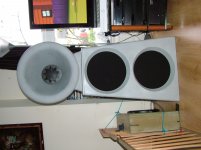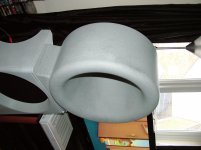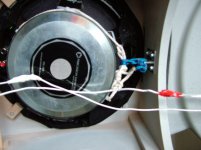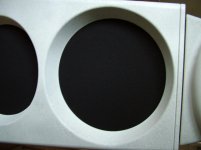Why is it that you look at Le in this context?
I mean - rising impedance is only affecting upper part of frequency response - and this particular FR is close to second to none with respect to its diameter.
Michael
Please refer to this paper:
http://www.adireaudio.com/Files/WooferSpeed.pdf
adire marketing paper
Hi Telstar,
IMO the 10 year old "white paper" as Adire called it was a red herring at best and a misleading and damaging attempt to deceive at worst.
Without wasting everyone’s time with an off topic rant ( although I do love the occasional rant...!) the dazzling maths are of dubious relevance to the conclusion.
Their master proof is a real sweetie...They test a driver for speed and get result of X. They then double the Mms and carry out an identical test and... there is no measurable ( or audible...?!) difference, WOW!
They have proved the laws of physics wrong, let’s all rush out and buy the new (patented of course...) driver.
Please forgive my sarcasm here but this sort of stuff should always be exposed for what it is. I have grown tired of long (and boring ) technical arguments about this adire paper.
We all make mistakes and now the Adire / AE designers have some superb "fast " drivers with ultra low Mms and strong Bl, now I can 100% agree with the physics of this. Low Le is good to extend frequency response and lower inductance = lower energy storage which is good. But, IMO, the mechanical energy storage / dissipation characteristics of a driver are far more important, see Michael for more details...!!
All the best
Derek.
Hi Telstar,
IMO the 10 year old "white paper" as Adire called it was a red herring at best and a misleading and damaging attempt to deceive at worst.
Without wasting everyone’s time with an off topic rant ( although I do love the occasional rant...!) the dazzling maths are of dubious relevance to the conclusion.
Their master proof is a real sweetie...They test a driver for speed and get result of X. They then double the Mms and carry out an identical test and... there is no measurable ( or audible...?!) difference, WOW!
They have proved the laws of physics wrong, let’s all rush out and buy the new (patented of course...) driver.
Please forgive my sarcasm here but this sort of stuff should always be exposed for what it is. I have grown tired of long (and boring ) technical arguments about this adire paper.
We all make mistakes and now the Adire / AE designers have some superb "fast " drivers with ultra low Mms and strong Bl, now I can 100% agree with the physics of this. Low Le is good to extend frequency response and lower inductance = lower energy storage which is good. But, IMO, the mechanical energy storage / dissipation characteristics of a driver are far more important, see Michael for more details...!!
All the best
Derek.
Last edited:
Driver choices
Hi All,
Back on topic, driver choice for Stig Eriks speaker.
As DIY is all about max quality for min £ expenditure, buying dozens of different drivers to test is not an option, so I hope the following paper spec test will help narrow the field down a good bit and save everyone some time and money...!
IMO the important tech specs and variables are :
(1) Mms dived by Bl
(2) Bandwidth the driver needs to cover
(3) Efficiency and smooth frequency response over the required bandwidth
(4) Point source Vs Sd ie 1 big driver Vs 2 or more smaller drivers
(5) Power handling / thermal compression
(6) Cone / suspension material / rigid chassis
As a general guide I can recommend using the Mms divided by Bl to give you a good feel for driver suitability. With 12 inch drivers for example my reference is e the Beyma 12LX60, 90g Mms divided by 20.3 Bl = 4.4.
This driver had killer bass down to 25Hz in the Encore cabinet. It was still fast enough to cross over at 400Hz to the Manger and no customer or reviewer was ever able to "hear the join". This was the best choice in a two way system.
For Stig Erik and all you guys building versions of his design you are free to go to faster lower mids and mids ie the Beyma 12 inch 12 G40 at 62g divided by 18.4 Bl = 3.3.
Even faster is the Beyma 12P80 Nd, Mms 64g/ Bl 23.7 = 2.7.
Point 1 is a great guide, but points 2 to 6 above must also be carefully considered. All good speaker / crossover systems are a careful blend of compromises. Change one parameter / spec and something else pops out of position elsewhere, cause and effect every time.
I have attached a couple of pics of my Christmas project, still developing it but I can’t stop listening long enough to any more work....!
Cheers
Derek.
Hi All,
Back on topic, driver choice for Stig Eriks speaker.
As DIY is all about max quality for min £ expenditure, buying dozens of different drivers to test is not an option, so I hope the following paper spec test will help narrow the field down a good bit and save everyone some time and money...!
IMO the important tech specs and variables are :
(1) Mms dived by Bl
(2) Bandwidth the driver needs to cover
(3) Efficiency and smooth frequency response over the required bandwidth
(4) Point source Vs Sd ie 1 big driver Vs 2 or more smaller drivers
(5) Power handling / thermal compression
(6) Cone / suspension material / rigid chassis
As a general guide I can recommend using the Mms divided by Bl to give you a good feel for driver suitability. With 12 inch drivers for example my reference is e the Beyma 12LX60, 90g Mms divided by 20.3 Bl = 4.4.
This driver had killer bass down to 25Hz in the Encore cabinet. It was still fast enough to cross over at 400Hz to the Manger and no customer or reviewer was ever able to "hear the join". This was the best choice in a two way system.
For Stig Erik and all you guys building versions of his design you are free to go to faster lower mids and mids ie the Beyma 12 inch 12 G40 at 62g divided by 18.4 Bl = 3.3.
Even faster is the Beyma 12P80 Nd, Mms 64g/ Bl 23.7 = 2.7.
Point 1 is a great guide, but points 2 to 6 above must also be carefully considered. All good speaker / crossover systems are a careful blend of compromises. Change one parameter / spec and something else pops out of position elsewhere, cause and effect every time.
I have attached a couple of pics of my Christmas project, still developing it but I can’t stop listening long enough to any more work....!
Cheers
Derek.
Attachments
Yes, I see - but I don't agree - as quite often with these guys.
Basically all that "speed" and "transient response" babble is seen much easier in a simple FR plot.
The higher the roll off starts the better in transient. Veeeery simple - but of no real help, as most if us cut drivers down by XO for some other reasons. You will have a hard time to explain what difference in "transien" it makes putting an additional coil in series versus increasing the voice coil inductance - for example.
What I was pointing out is a different *quality*.
As far as I know, there is no spec yet to characterize what I outlined about the impact of friction - simply not enough interest by speaker designers in this for the last few decades I guess...
Michael
Last edited:
More pics
Hi All,
VPL sides give effective baffle width of over 1 meter with none of the cuppy, boomy tunnel effects of a backless box.
Also the greatly reduce the audible effects of the baffle step as the "step" is now a gentle slope...!
Front baffle is 60mm thick with CNC machined mini wave guides on the Precision devices 15 inch low mid and Beyma 15 inch SM115K bass. Changing this to a 15 inch Precision devices driver, twice the price but worth it for sure.
Will use stainless steel wire to hang the drivers, the rope is too ugly!
Planning some changes to Manger horn profile / dimensions.
Performance is off the scale, too many old audio clichés spring to mind so all I can say is I am very, very happy...!
How about trying Stigs design with a pair of Mangers replacing the TPL / ribbons, Seas 5 /8 inchers?
Manger down to 400Hz, a single 15 inch or pair of 12 inch driver covering 400Hz down to 60Hz to 80Hz and then Stigs "mother of all OB subs" (love them!) covering low / sub bass?
Cheers
Derek.
Hi All,
VPL sides give effective baffle width of over 1 meter with none of the cuppy, boomy tunnel effects of a backless box.
Also the greatly reduce the audible effects of the baffle step as the "step" is now a gentle slope...!
Front baffle is 60mm thick with CNC machined mini wave guides on the Precision devices 15 inch low mid and Beyma 15 inch SM115K bass. Changing this to a 15 inch Precision devices driver, twice the price but worth it for sure.
Will use stainless steel wire to hang the drivers, the rope is too ugly!
Planning some changes to Manger horn profile / dimensions.
Performance is off the scale, too many old audio clichés spring to mind so all I can say is I am very, very happy...!
How about trying Stigs design with a pair of Mangers replacing the TPL / ribbons, Seas 5 /8 inchers?
Manger down to 400Hz, a single 15 inch or pair of 12 inch driver covering 400Hz down to 60Hz to 80Hz and then Stigs "mother of all OB subs" (love them!) covering low / sub bass?
Cheers
Derek.
Attachments
Hi All,
Back on topic, driver choice for Stig Eriks speaker.
material / rigid chassis
As a general guide I can recommend using the Mms divided by Bl to give you a good feel for driver suitability.
Derek.
Hi Derek, I was on that Bl and Mms trip for a while too - but essentially this calculations are meaningless.
- you either get enough bandwidth / transient response - which is quite simple FR - or not, for the app given.
- you either get enough sensitivity - which is quite simple looked up in specs - or not for the app given.
thats it - no number mystery here.
What *is* different - and can not reliably calculated fom TSP - is the amount of friction involved.
As said - friction provides a change in wave form - hence creates distortion.
This effect is pretty low IMO and I don't think we will see it in a "pure" form with speakers anyway.
A good starting point if I ever would like to trace it down by measurements would be to do low SPL measurements.
If you imagine "stick slip" - the worst case of friction - to happen, it probably would not even show up in high SPL measurements.
Not that I expect "stick slip" to happen in its pure form - just as an example.
Same as said for the "stick slip" example holds true for relatively low amounts of friction.
Friction as I refer to, being meant as basically independent of membrane velocity of course - thats key !
Michael
Last edited:
Very nice work there Derek!
Now back to the "mother of all OB subs"
Whats wrong with the grandmother? I will test my twin 21" OB sub in upright position as well, which raises an interesting question: why not THREE woofers? A small tower, just short of 2 meters tall? I'm not crazy (yet).
Now back to the "mother of all OB subs"
Whats wrong with the grandmother? I will test my twin 21" OB sub in upright position as well, which raises an interesting question: why not THREE woofers? A small tower, just short of 2 meters tall? I'm not crazy (yet).
Stick Slip
Hi Michael,
This Stick Slip is a new idea to me, can you explain a little more?
I hear what you are saying re the Mms/ Bl figure but I have found it to be a useful guide. Maybe I have just been lucky as I have not sampled 100,s of drivers, only about 25 different bass and bass / mid drivers so it’s not a huge sample.
The Cms figure is also one I look at. Suspension compliance / material is pretty major. Generally thick rubber is bad, treated / pleated linen is good.
The friction of the spider, surround / suspension must be another major factor.
How do we relate a measurement of it to sound quality?
Cheers
Derek.
Hi Michael,
This Stick Slip is a new idea to me, can you explain a little more?
I hear what you are saying re the Mms/ Bl figure but I have found it to be a useful guide. Maybe I have just been lucky as I have not sampled 100,s of drivers, only about 25 different bass and bass / mid drivers so it’s not a huge sample.
The Cms figure is also one I look at. Suspension compliance / material is pretty major. Generally thick rubber is bad, treated / pleated linen is good.
The friction of the spider, surround / suspension must be another major factor.
How do we relate a measurement of it to sound quality?
Cheers
Derek.
Subwoofers with 90 degrees phase shift!
An externally hosted image should be here but it was not working when we last tested it.
why not THREE woofers? A small tower, just short of 2 meters tall? I'm not crazy (yet).
I better not say
Well, why not a couple more subs...one on each side of mains
Approaching the wall of sound
Actually I wanted to do this a long time ago, using multiple AE IB15
Made thread too
Now back to the "mother of all OB subs"
... why not THREE woofers? ...
I'm not crazy (yet).



Just in case this men with the white jacket knock your door, we will be at your disposal to find convincing arguments :
- "it looks soooo good" (no one can argue that) – than go towards more technical speech :
- "you know guys – you can't beat Sd" – after that you can continue with whatever comes into your mind – as this *jerks* most probably have no idea about building speakers
LOL
Well - I EQ *down* a single 12" Peerless !
Michael
Last edited:
Hi All,
Will use stainless steel wire to hang the drivers, the rope is too ugly!
Derek.
How you like hanging drivers so far?
Michael
This Stick Slip is a new idea to me, can you explain a little more?
"Stick slip" I just brought as an example – as I thought many might be familiar with – I don't expect it to play a important role with speakers actually.
To become familiar with, I recommend to do a simple experiment:
Take a spring (a rubber band will do as well) and attach to a mass (your PC mouse for example) - than gently try to pull that mass.
Most certainly you will not be able to pull gently enough to not move that mass without jumping towards you at first (well a little bit)
This is caused by the circumstance that friction is different when velocity is zero from when there is movement – defined by different coefficients for mass moving or resting.
Usually (not in all cases) the friction for resting mass is higher – meaning you have to stretch your spring slightly more to simply get the mass moving as is needed to keep it moved.
Thus "stick – slip" – it plays an important role if you have to position very accurately and within small distances for example.
The friction of the spider, surround / suspension must be another major factor.
How do we relate a measurement of it to sound quality?
I have not tried to trace my theory down by measurement, yet – so its kinda guesswork.
Basically friction causes distortion figures to *not* diminish monotony with lower SPL – meaning – this kind of distortion starts to stick out at lower SPL and gets masked with higher SPL.
You can have a look at how friction affects waveform if you still have your PC mouse at the rubber band (or whatever you used).
Hold it 90 deg (vertically) in free air – stretch the spring and release – the result is a perfect sine movement with an exponential decay envelope. Exactly the behaviour what we are after with speakers.
Now – tilt you breakfast table (or anything else) to somewhere 80 deg - put you PC mouse on it - and repeat the experiment above.
You will notice that the friction between PC mouse and table will not only shorten the decay but also significantly change the smoothness of the sine movement towards a saw tooth style of movement. This is the signal distortion occurring by friction we are after.
Michael
Last edited:
I hear what you are saying re the Mms/ Bl figure but I have found it to be a useful guide. Maybe I have just been lucky as I have not sampled 100,s of drivers, only about 25 different bass and bass / mid drivers so it’s not a huge sample.
Regarding the BL mms figure I would not say that its meaningless
You best try for yourself :
Calculate your figure for a lot of drivers and then normalize to Sd – then you correlate to sensitivity spec – surprise - most probably you will find out that you went in circles.
Meaning – BL, Mms and Sd give the basic ingredient for senstivity – its just an other way to look at it .
Michael
Michael - very interesting ideas you have there. It would explain why I always thought woofers with very high Qms sounded better.
A very high Qms / Qes ratio would mean that the movement of the cone is mostly controlled by the voice coil, or what? I like that idea.
Yeah - sort of.
The only culprit here is that Qms is not *only* related to (velocity independent) friction.
If you imagine a motor design optimised for low power compression figures you can use the dust cup to pump some air through the VC gap.
This would also cause kinda friction – same as in shock absorbers for cars for example.
This kind of friction is almost perfectly related to velocity of membrane and hence does NOT cause the wave form distortion of *friction that is independent to velocity*.
You can not distinguish between the two forms of friction mixed into Qms figure - I mean - Thiele and Small were not after distortion at all - so we would need a new spec to be defined....
Michael
Last edited:
...run out of time...
From above, even low Qms speakers could sound as you and I like it *if* low Qms is NOT due to *friction that is independent to velocity* - my bottom line a few postings back:
low Qms not necessarily indicates high *friction that is independent to velocity* but high Qms most certainly indicates low *friction that is independent to velocity*....
Michael
From above, even low Qms speakers could sound as you and I like it *if* low Qms is NOT due to *friction that is independent to velocity* - my bottom line a few postings back:
low Qms not necessarily indicates high *friction that is independent to velocity* but high Qms most certainly indicates low *friction that is independent to velocity*....
Michael
"Interesting ideas"
Hi Michael,
I agree with Stig Erik, very interesting ideas you have.
I really appreciate the way you give clear and simple analogies / experiments (i.e. PC mouse / rubber band angle the desk) to explain your technical points which obviously comes from your much deeper ( than me anyway..!) understanding of Physics. Thanks!
In my system I rate the sonic improvement from " hanging the drivers " very highly. Bigger upgrade than doubling the amount of money you spend on drivers. The main sonic improvements are:
(1) An obvious reduction in lower "hash and noise" that I didn’t notice until it was gone! This was more audible with the 15 inch cones than the Manger.
(2) Much better focus ( and it was great to begin with!)
(3) More "liquid sound" i.e. so easy to get lost in the music and forget to analyse the sound.
(4) Astonishing transits and slam. Really wow stuff on percussion and big band brass / horn sections!
I am using a large SD of driver to relatively small cabinet area ( twin 15 inch drivers close together, 60mm thick solid MDF trapezoid baffle, shallow VPL sides and small top)
The improvements will vary with Sd total Vs area of baffle / speaker cabinet.
Cheers
Derek.
Hi Michael,
I agree with Stig Erik, very interesting ideas you have.
I really appreciate the way you give clear and simple analogies / experiments (i.e. PC mouse / rubber band angle the desk) to explain your technical points which obviously comes from your much deeper ( than me anyway..!) understanding of Physics. Thanks!
In my system I rate the sonic improvement from " hanging the drivers " very highly. Bigger upgrade than doubling the amount of money you spend on drivers. The main sonic improvements are:
(1) An obvious reduction in lower "hash and noise" that I didn’t notice until it was gone! This was more audible with the 15 inch cones than the Manger.
(2) Much better focus ( and it was great to begin with!)
(3) More "liquid sound" i.e. so easy to get lost in the music and forget to analyse the sound.
(4) Astonishing transits and slam. Really wow stuff on percussion and big band brass / horn sections!
I am using a large SD of driver to relatively small cabinet area ( twin 15 inch drivers close together, 60mm thick solid MDF trapezoid baffle, shallow VPL sides and small top)
The improvements will vary with Sd total Vs area of baffle / speaker cabinet.
Cheers
Derek.
- Home
- Loudspeakers
- Multi-Way
- My open baffle dipole with Beyma TPL-150




